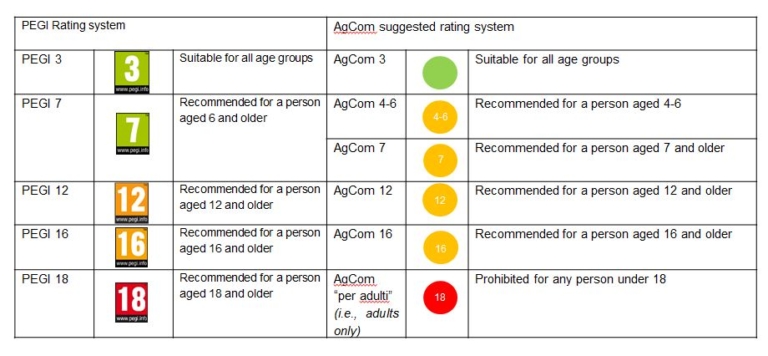Upcoming Italian regulations on video game content and age ratings and their impact on the PEGI system
Published on 15th August 2018
On 28 December 2017 the Legislative Decree no. 203/2017 was issued to provide new rules specifically designed to enhance the protection afforded of minors in the audiovisual sector.
With respect to videogames, article 10 of the Legislative Decree has delegated the issuing of new regulations introducing a new content and age rating system to the Italian Communications Regulatory Authority (AgCom) setting some parameters that the new classification system must comply with. In particular, the new classification system will have to:
- Take into due account the fundamental right to freedom of expression;
- Be coherent with the existing rules concerning radio and audiovisual media services, with particular regard to the rules designed to protect minors;
- Align with the videogame industry best practices, which include existing self-regulatory classification systems like PEGI.
The classification system proposed by the Italian Communications Regulatory Authority and the differences vs. the PEGI system
On 8 May 2018 AgCom published a Draft Regulation for comments by all interested stakeholders before becoming final. Although the text of the Draft Regulation may change as a result of the public consultation, taking a look at the provisions of the Draft Regulation in its current text as well as at some of the questions raised by AgCom to fuel the debate on some key points that the new Regulation should, in AgCom’s view, address, may give us a sense of where the Italian Authority is headed.
On a general note, the Draft Regulation (i) provides that videogames should be rated based on age /age classes, taking into consideration the games education value, (ii) makes explicit reference to the PEGI standards, and (iii) makes no reference to online videogames stores. However, one point on which AgCom seems keen to receive input in relation to the question whether or not the new system should “encourage the adherence of online stores to the International Age Rating Coalition (IARC)”.
As shown in the table below, the classification suggested in the Draft Regulation presents some deviations from the PEGI rating system also in relation to the use of pictogram colors.

In short, the Draft Regulation (i) keeps the green pictogram only for use to identify games suitable for all age groups, and (ii) include easy to play and board games-like family videogames in the 4 to 6 age group, whilst leaving in the 7+ age group only family games which are more competitive and whose gameplay is more fast-paced.
Moreover, the Draft Regulation introduces requirements that are designed to ensure adequate visibility of the pictograms, and in particular:
- the green pictogram must be displayed on-screen for the entire game-playing experience;
- the 4-6; 7; and 12 and 16 age group pictograms must be displayed in full-screen mode for at least 12 seconds before the gameplay is allowed to start;
- the 18 pictogram must be displayed in full-screen mode for at least 12 seconds before the gameplay is allowed to start and must also be displayed on-screen for the entire game-playing experience.
It should be noted that together with the pictogram indicating the relevant age group suitability, content descriptors (e.g., violence, bad language, sex, drugs, etc.), which in the Draft Regulation are identical to the PEGI’s ones, should be displayed for the entire game-playing experience.
In conclusion, the Draft Regulation, whilst explicitly referring to the PEGI rating system, may introduce a classification system that is similar but not identical to the PEGI classification system and provides very precise visibility requirements for the relevant descriptors/ pictograms.
What are the sanctions for non-compliance?
The Legislative Decree no. 203/2017, delegating the issuing of secondary legislation to AgCom, is silent on what sanctions may be triggered by non-compliance with the forthcoming videogame classification systems.
As a consequence, AgCom currently would lack the power to apply any direct sanctions in the event of non-compliance with the new rules. However, AgCom will be entitled to issue an order requesting compliance with the new rules and, in the event the requested party fails to comply with AgCom’s order, AgCom will then apply fines.
Failure to comply with an AgCom’s order may trigger the application of administrative fines ranging from Euro 10.329,00 to Euro 258.228,00.
The results of the public consultation on AgCom’s new Draft Regulation
The public consultation ended on June 7 2018. However, AgCom has not released yet the final text and at this point in time we don’t know to what extent the text of the Regulation that will eventually become final deviates from the text submitted by AgCom for public consultations. Equally, the contributions submitted by the industry stakeholders in respect of the Draft Regulation are not publicly available with the exception of the comments provided by AGIA, the Italian body dealing with the protection of children's rights. AGIA has already made public that advocates a solution whereby, for the purposes of assessing what age rating should be assigned to a specific game, regard should be have also to whether or not a videogame includes (i) in-app purchases, and/or (ii) in-game online chats. Moreover, AGIA’s takes the view that the new Regulation should require parental consent to allow a child to play a game that includes these features.
This is because, clearly, AGIA believes that the presence of in-app purchases and online chats are inherently dangerous for the wellbeing of children.
What next?
We expect AgCom should issue the final text of the Regulation between the end of the summer and the beginning of autumn of this year. Also, the Draft Regulation indicates that, following the entry into force of the new Regulation, AgCom will, after consulting with the industry stakeholders, issue operational guidelines that, we should expect, will clarify how the new classification system will work in practice, so… watch this space!


